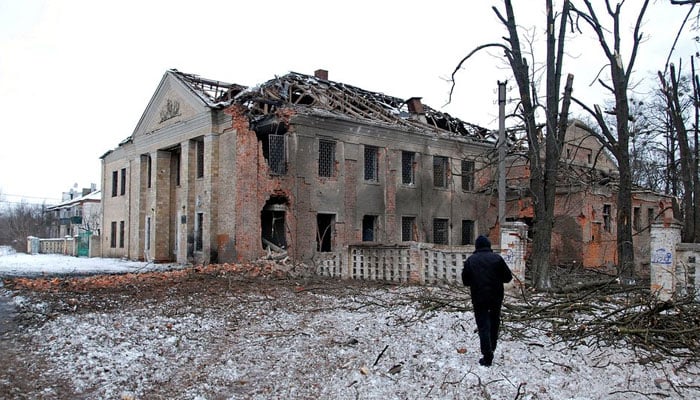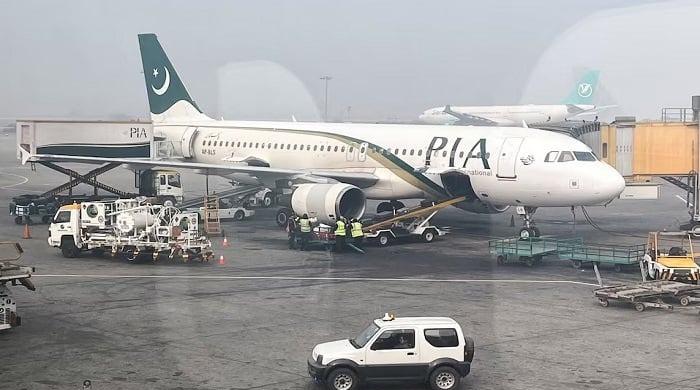What the ongoing Ukraine-Russia crisis means for Pakistan
Food and fuel are a larger part of Pakistan's spending, and both are bound to increase due to the Ukraine-Russia conflict
March 21, 2022

At the onset of the pandemic, experts warned about three challenges facing humanity: COVID-19, food crisis, and a global recession. While COVID-19 inflicted unprecedented losses, fortunately, the world escaped a global recession and food crisis. However, that escape seemed short-lived. Once again, experts are warning of a food crisis and a global recession, but this time the crises will not be triggered by a pandemic but due to the ongoing Russia-Ukraine war.
Consumers worldwide may not realise the gravity of the situation as the crisis is not reflected correctly through the retail prices of fuel and food yet. However, if a de-escalation between Russia and Ukraine (which seems unlikely as the situation stands now) does not happen soon, the world seems set to go into recession and face a food crisis in the next few months. Let me explain how.
First things first, why would supply chain disruption from these two countries affect the global commodity prices? Russia is the world’s largest, second-largest, and third-largest exporter of natural gas, oil, and coal. Hence, it has the lion’s share in the global energy supplies, especially in Europe, where Russia meets 40% of the gas requirements and 80% of the coal requirements. Russia accounts for 11% of global wheat supplies, one-tenth of the world’s aluminum and copper, and one-fifth of battery-grade nickel. America meets half of its uranium requirements (for energy generation) from Russia.
Moreover, Russia produces 40% of the world’s palladium and 80% of the world’s vegetable oil. Russia, along with Belarus, is an important source of the world’s potash and phosphoric fertilisers. Ukraine, too, is one of the largest global exporters of wheat (we have been importing from Ukraine in the past) and sunflower seeds. It provides about half the world’s neon.
Russia and Ukraine together cater to more than one-quarter of the global export of wheat, one-sixth of corn, one-third of barley, and about 80% of sunflower oil and sunflower-seed meal.
Global commodity prices were already on an upward trajectory due to an increased demand thanks to an earlier than expected recovery from COVID-19. The war between Russia and Ukraine further aggravated the situation, and the world observed its biggest commodity shock since 1973. Overall, indices of commodity prices are now 26% higher than at the start of 2022. Brent Crude oil which is currently hovering at around $100 a barrel (as only the US had embargoed import of oil from Russia), had soared to $139 a barrel amid fear of joint sanctions by the US and EU. Here it is pertinent to mention that a complete global embargo, enforced by the US, could send the oil price towards $200 a barrel. Already European gas prices have trebled amid panic that Russia may block the gas supply.
One of the worst disruptions to wheat supplies since World War I is pushing the prices of wheat up. Likewise, prices of palm and soybean oil are on the rise as a substitute for sunflower and vegetable oil.
More than 400 Western brands and chains have closed their business in Russia amidst sanctions by the West. However, while it has become clear that Russia can survive without Western finished goods, for the rest of the world to survive without Russian raw material is economically painful. That is why Russian raw material exports have been spared the kind of comprehensive sanctions the West has imposed on other sectors.
In an average year, Russia exports seven to eight million barrels of oil per day (bpd). Experts say that even the combined additional oil supplies from the US (up to 1m bpd), OPEC members (up to 1-2 m bpd), and Iran (1m bpd) if sanctions are lifted from it, would only compensate for half of the Russian oil supplies. These additional supplies would take at least one year to come into effect because most oil producers have not invested in new fields for years.
Russia has threatened to cut off Europe’s energy supply in retaliation to Western sanctions. Even if it does not do so and the West does not put a complete embargo on Russian commodity exports, the de-facto sanctions are already there.
Lenders, insurers, and shipping firms are reluctant to strike deals to carry Russian cargoes due to the Western sanctions on Russian banks. On the other hand, most of the foreign banks (including Chinese ones), wary of steep penalties, are not issuing letters of credit for Russian trade. Container operators like Maersk and MSC have pulled away from Russia. Some vessels taking Russian goods were intercepted by Western navies, while a few got hit by missiles in the Black Sea. Hence, commercial shipping is almost suspended there and Russian supply chains are already disrupted.
The volatility and uncertainty in the global stock markets are also contributing to the forthcoming recession. Oil prices moving in the range of $100 a barrel to $140 a barrel in a single week, widely fluctuating wheat prices, gas suppliers defaulting on their long-term cargo supply contracts, and a halt on the trading of metals in the major commodity exchange markets, etc, are signs of a giant storm.
The IMF, World Bank, and other top global lenders warned last Friday of the extensive economic fallout of the Ukraine crisis. In a joint statement, they have warned that the conflict is increasing poverty and pushing inflation up further: “The entire global economy will feel the effect of the crisis through slower growth, trade disruptions, and steeper inflation, harming especially the poorest and most vulnerable”. Global inflation, already at 7%, may rise by another two to three percentage points, to a level last seen for a sustained period in the early 1990s.
How could Pakistan, which is currently dealing with political turmoil, be affected by this situation? Food and fuel are a larger part of our spending, and both are bound to increase. We saw our long-term LNG suppliers defaulting on two consignments of March, compelling us to buy expensive gas from the spot market. Expect more such defaults in the months to come. The prime minister gave his relief package when the crude prices were $88 a barrel. Those are now hovering around $100 and can quickly rise to US$150 with any wrong move by Russian or Nato forces. Freezing the prices of oil in Pakistan is not only a huge fiscal challenge but is also contributing to our current account deficit (CAD), which for the first eight months of the current fiscal year is $12.1 billion; the import of oil forms a major chunk of it.
On the food front, one is expecting to miss the yield target of wheat due to a shortage of urea fertiliser during the sowing season. International wheat prices are bound to increase further. Globally higher wheat prices would be an added incentive for domestic investors to smuggle wheat to western neighbours. Any domestic wheat shortage would compel the government to import expensive wheat, ultimately leading to an increase both in the domestic flour prices and CAD. The same is true for edible oil imports which would turn more expensive.
To meet the balance of payments, we would require external assistance. The result of the IMF review mission, as well as China’s response to our $21 billion assistance request, are awaiting the outcome of the no-confidence motion against the PTI government.
This anticipated food and fuel inflation would erode into the political capital of any party/parties in power. A consensus among all political forces on a minimalistic economic agenda is a must to minimise the ripple effects of the global recession and a looming food crisis. Difficult times are ahead for the winner in parliament on March 28 — not only on the political front but also on the economic front.
The writer heads the Sustainable Development Policy Institute. He tweets @abidsuleri
Originally published in The News









